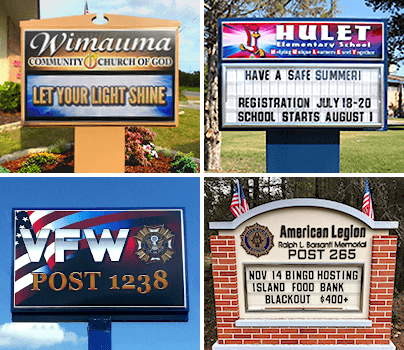Signage plays a significant role in the awareness of an organization's location and events. A sign can be the first impression for those who have never visited and an extension of the identity within. So what should you consider when determining the type, style, size and cost of a sign? Here are five questions to answer before you order.
1. What does the sign need to communicate?
Sometimes the simplest questions yield the best answers. It is important to consider how a sign will either reflect your organization. You should ask yourself what the real purpose of the signage may be.
2. What sign is best for our community?
Before choosing a sign according to its possible community appeal or aesthetics - check zoning regulations. Zoning laws in your area will dictate many of your sign decisions. In particular the three big questions of size, site and set-back, are largely answered by local regulations.
There are some exceptions to this, for instance if you are public school you are likely exempt from zoning which can be verified through your district. In addition, if there are zoning restrictions in your area you have the option of filing for a variance.
3. Where should we put the sign and how big should it be?
Placement is critical – passing drivers cannot read a sign that is parallel to the road. Generally, perpendicular signs are much more readable. Be sure to place the sign on the busiest street bordering the property and to make the sign double-sided for twice the impact.
4. How will we pay for the sign?
When it comes to budgeting, understand the differences between commercial and institutional-grade signs. Churches, schools and municipalities typically want an institutional-grade sign because it lasts an average of 25 years. The durability of an institutional-grade sign is reflected in a higher price — sometimes twice the price of a similar commercial-grade sign.
Higher quality in sign features make the difference between a sign that lasts decades and one that lasts only a few years. A fade-resistant painting process, high-grade materials that do not yellow or become brittle with age, and a lifetime warranty are some of the features that will cost more, but last much longer.
5. Where will we buy the sign?
Placing your trust with a particular supplier can be easy if you have evaluated the company beforehand. Here are some questions to ask yourself before working with anyone:
Is this company respected in the marketplace?
Get references from a company you are considering. Look at examples of their signs at other organizations in your area.
Talk with those who may have served on a sign committee and dealt with a particular company.
What is their warranty?
This will let you know if the company stands behind its products and customers you speak with should have peace of mind about this.
In addition, consider the amount of customer care provided by a company.
How long have they been in business?
The longevity of a company and the number of signs they have in the field speaks volumes. A warranty is only good if the company is there to stand behind it.
